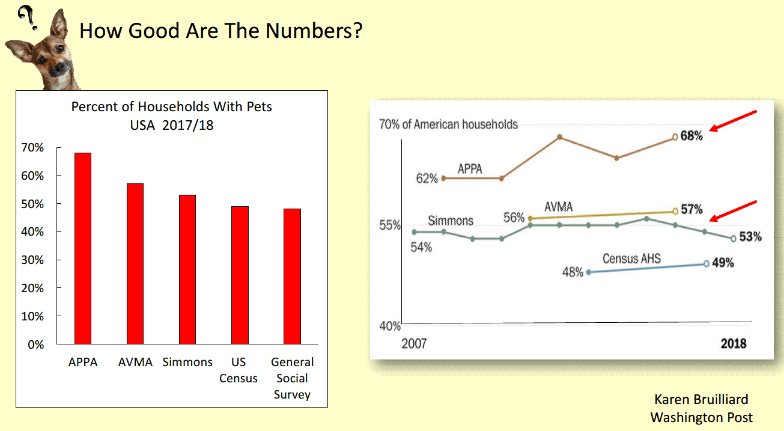
Jul 30, 2019 How Many Dogs Are in a Particular Place or Region?
Posted at 06:30h
The 2019 conference of the International Society for Anthrozoology (ISAZ) was held in Orlando at the beginning of July. One of the talks on dog demographics, prepared by Drs. Harold Herzog and Andrew Rowan, was given by Dr. Harold Herzog and produced a lot of reaction (tweets ranged from “thought provoking” to “remarkable differences in rates of dog ownership”) and questions. (The charts are taken from the slides Dr. Herzog used for his talk, “Geography, Demography, and Patterns of Pet-Keeping: The Case of Dogs.”)
Over the years, it has always been something of a surprise that so little attention has been given to a better understanding of dog (and cat) demographics in human society. As the Herzog talk illustrates, there is a large variation in the results from different surveys with the reported percentage of households with dogs ranging from 49% to 68%. Typically, whenever a survey publishes its results, people simply quote the numbers uncritically without any understanding of or apparent interest in determining the accurate number of dogs and cats or why the survey results differ so much.

Over the years, it has always been something of a surprise that so little attention has been given to a better understanding of dog (and cat) demographics in human society. As the Herzog talk illustrates, there is a large variation in the results from different surveys with the reported percentage of households with dogs ranging from 49% to 68%. Typically, whenever a survey publishes its results, people simply quote the numbers uncritically without any understanding of or apparent interest in determining the accurate number of dogs and cats or why the survey results differ so much.
According to Euromonitor (a large market research company), the number of pet dogs in forty different countries averages around 110 dogs per 1,000 people but the actual values range from over 200 dogs per 1,000 in the USA, Mexico, Hungary and the Czech Republic to under 25 per 1,000 in Singapore, China, Turkey, Malaysia, Egypt and India. But the number of pet dogs does not include the additional community/street dogs in some parts of the world. In Latin America and Pacific Island countries (not Japan or Taiwan), the proportion of the total dog population that lives on the streets is around 50%. In India, Indonesia and Africa that proportion is closer to 70% or higher.
The differences detailed above are not simply academic. Undertaking a street dog program in Latin America or the Philippines will, other factors being equal, cost a lot more than a similar project in India simply because there are a lot more dogs in Latin America or the Philippines. Also, it is surprising that there has been so little academic research into the reasons for the differences in dog ownership around the world. It is easy to explain why predominantly Muslim countries have fewer dogs than non-Muslim countries, but why does India have so many fewer dogs than the Philippines? Why does the rate of dog ownership (reported as dogs per 1,000 people) in Europe differ by a factor of almost three from one country to another?
There are indications that academic interest in dog (and cat) demographics is increasing. A review of the scientific literature on pet population dynamics (Kay et al, 2017, Prev. Vet. Med. 144:40) reported that there were 61 relevant papers published before 2000 (between 1975 and 2000), 76 published between 2000 and 2009, and 98 from 2010 through 2015. This represents a 4- to 5-fold increase in the rate of publication on pet populations over 40 years. In addition, there is a growing concern over the issue of pet homelessness both to improve pet health but also to reduce the negative impact of pet dogs and cats on wildlife.


